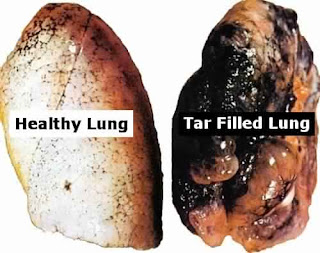Globally, tobacco
use killed 100 million people in the 20th
century, much more than all deaths in World Wars I and II combined.
Worldwide, tobacco use causes nearly 6 million deaths per year. On
average, smokers die 10 years earlier than nonsmokers.
Researchers have estimated that cigarette smoke
has nearly 7,000 chemical compounds. It means you are not smoking only a cigarette
but it is bunch of chemicals going inside your body with inhaled a puff.
Among these
chemicals
1,3-butadiene causing cancer risk,
Acrolein and acetaldehyde causing respiratory irritation
Cyanide, arsenic, and the cresols causing cardiovascular risk.
Nicotine present in cigarette is reason behind addiction of cigarette which reaches the
brain within 10 seconds after inhalation of first puff and remains active for
20-40 minutes.
Nicotine is both Central Nervous System (CNS) stimulant and depressant. As it creates
stimulating effect on heart and gastrointestinal tract, it also relaxes the
body and creates a state of gentle euphoria. It means it activates you as well
as relaxes you too.
Cigarette smoking is
a complex behavior that over time becomes powerfully compulsive.
Tobacco addiction is considered to consist of two
medically defined disorders
1. Nicotine Dependence
2. Nicotine withdrawal
Nicotine Rush: Nicotine alters the balance of two
chemicals, called dopamine and noradrenaline, in your brain. When nicotine
changes the levels of these chemicals, your mood and concentration levels
change very quickly which produces feelings of pleasure and reduces stress and
anxiety.
This is why many smokers enjoy the nicotine
rush and become dependent on it.
Nicotine makes the
brain release the nor-adrenaline that gives you the feeling
of “HIGH”.
When you stop
smoking, the loss of nicotine changes the levels of dopamine and noradrenaline.
This can make you feel anxious, depressed and irritable.
It’s normal to crave nicotine when you
quit, as smoking provides an immediate fix to these unpleasant feelings.
Nicotine activates the reward system of body
through release of dopamine. This reward center is responsible for lots of motivation
you feel.
Regular users feel like they need to smoke as
reward for getting through the day, surviving a few hours of work or for
passing test.
Because the chemical changes caused by nicotine
makes them feel like they are being rewarded by having cigarette.
Tolerance to the effects of nicotine develops with repeated use of tobacco and
consequently consumption increases over time but produces only relatively weak
effects compared to when smoking first began.
Nicotine increase the heart rate, causes an
increase in how much oxygen you consumes, increase the secretion of gastric
acid and suppress the hormone secretion.
It is well said and proven that your heart is working overtime to cop up with
changes produced by the presence of nicotine inside the body.
Carbon monoxide present in the
inhaled smoke is reason behind making the blood thicker.
The Tar is the collective
term for the various particles suspended in tobacco smoke. The particles
contain chemicals, including several cancer-causing substances (carcinogens).
Tar is sticky and brown, and stains teeth,
fingernails and lung tissue.
It’s a myth that smoking helps to
concentrate and makes a smoker alert. In fact, the speed
and accuracy of a smoker’s thinking ability becomes weak. Smoking also lowers down the smokers’ IQ.
Although some studies have shown that the
nicotine in cigarettes can improve concentration
and attention (making
smokers feel more alert), there’s more to cigarettes than just nicotine. They
contain over 7,000 chemicals—over 50 of which are known to be toxic in nature.
Research here has found that passive or second
handed smoker have same health issues as active one including lung and
cardiovascular disease and cognitive and memory problems.
Quitting smoking improves health and leads to
improvements in cognition.
This may be linked to an increase in the
thickness of the brain’s cortex—the outer layer of the brain that plays a
critical role in information processing and memory.
The cortex naturally thins with age, but smoking
can worsen this effect causing the cortex to thin at an accelerated rate.
There is neither a safe tobacco product, nor a
safe level of tobacco use.









No comments:
Post a Comment